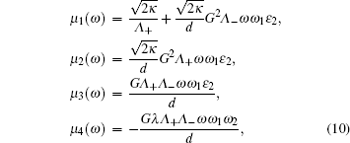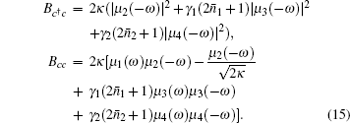† Corresponding author. E-mail:
We investigate the properties of the ponderomotive squeezing in an optomechanical system coupled to a charged nanomechanical oscillator (NMO) nearby via Coulomb force. We find that the introduction of Coulomb interaction allows the generation of squeezed output light from this system. Our numerical results show that the degree of squeezing can be tuned by the Coulomb coupling strength, the power of laser, and the frequencies of NMOs. Furthermore, the squeezing generated in our approach can be used to measure the Coulomb coupling strength.
The optomechanical system has sparkled the interest of a vast scientific community due to its distinct applications, ranging from sensing of masses, forces, and displacements at the ultimate quantum limits, to tests of the validity of quantum mechanics at a macroscopic level, up to the realization of quantum interfaces for quantum information networks. [ 1 – 4 ] In a typical optomechanical system, the coupling between a movable mirror and the cavity field can lead to many remakable effects, such as the optomechanically induced transparency (OMIT), [ 5 – 11 ] the quantum ground state cooling of the nanomechanical resonators, [ 12 – 14 ] entanglement between cavity modes and/or mechanical modes, [ 15 – 22 ] and squeezed states of the light or the mechanical modes. [ 23 – 25 ]
On the other hand, the squeezed light, where fluctuations in one quadrature of the optical amplitude drop below the level of vacuum noise, is interesting from both fundamental and practical points of view. Such light can be used to improve the measurement sensitivity in applications ranging from gravitational wave detection [ 26 ] to even biological measurements. [ 27 ] Squeezed states of light are also a key ingredient for continuous-variable information processing. [ 28 ] It is well known that the standard method for generating optical squeezing is to drive a nonlinear optical medium, [ 29 ] which has been realized in Ref. [ 30 ]. Recently, the squeezing of the transmitted field can also be achievable in optomechanical systems, [ 31 , 32 ] where cavity photons are coupled to mechanical motion by radiation pressure. The optomechanical method of manipulating the quantum fluctuations has been termed as “ponderomotive squeezing”, [ 30 ] which relies on the nonlinearity induced by the optomechanical interaction between the position of the oscillator and the intensity of the cavity mode. [ 31 , 33 ] Moreover, achieving this kind of ponderomotive squeezing experimentally is an important goal due to its applications in ultrahigh precision measurements. [ 34 – 36 ]
In this work, we demonstrate a tunable squeezed light observable in an optomechanical system, in which the two nanomechanical oscillators (NMO) are coupled through Coulomb force. We find that the single peak in squeezing spectrum is split to two peaks due to the Coulomb interaction. Specifically, the separation of the two optimal squeezing points can be tuned by the Coulomb interaction.
Compared to previous studies, [ 37 , 38 ] where the ponderomotive squeezing is generated in a cavity assisted by an atomic ensemble or in a ring cavity consisting of two mirrors without Coulomb force, our scheme owns some favorable features. First, the squeezed light generated in our scheme is created by Coulomb interaction. In addition, the Coulomb coupling has important advantages, for instance, the range of the interaction distance is from nanometer to meter, [ 39 – 41 ] the strength can be controlled by the bias voltage, [ 39 , 40 ] and it can also be applied to the different kinds of charged objects at different frequecies. [ 41 ] Second, the point with optimal squeezing can be tuned by the frequencies of the two NMOs. Finally, we find that the two optimal squeezing points are apart near linearly with respect to the Coulomb coupling strength. This feature reminds us of a practical application of the ponderomotive squeezing spectrum for detecting the Coulomb coupling strength. In this context, we have to emphasize that our proposal is essentially different from previous idea, [ 38 ] where the squeezed light is caused by the frequency difference between the two movable mirrors. In contrast, our studied squeezed light can be observed even for two identical movable mirrors.
The remainder of this paper is organized as follows. In Section 2, we present the model under study and analytical expressions of the optomechanical system, derive the quantum Langevin equations, and the steady state of the system. In Section 3, we quantify the squeezing properties of the system. Finally we draw our conclusions in Section 4.
As sketched in Fig.



Schematic diagram of the system.
Using the Heisenberg equations of motion, and considering photon losses from the cavity and the Brownian noise from the environment, we can obtain the following nonlinear quantum Langevin equations for the operators of the mechanical and optical modes: [ 42 ]



We can rewrite each Heisenberg operator as a steady-state value plus an additional fluctuation operator with zero-mean value, c = c s + δ c , q i = q i s + δ q i , p i = p i s + δ p i ( i = 1,2). Then we insert these expressions into the Langevin equations and obtain the steady-state values

Retaining only first-order terms in the small quantities δ o ( o = c , q i , p i ), the linearized Langevin equations for the fluctuations are given by

It is more convenient to work in the frequency domain because, experimentally, fluctuations of the electric field are more convenient to be measured in the frequency domain than in the time domain. Using the following Fourier transform for an operator u ( u = δc , δ p i , δ q i , c in , and ξ i ),



By solving Eq. (



It was shown that the optomechanical coupling can lead to squeezing of the nanomechanical motion, which can be inferred by measuring the squeezing of the transmitted microwave field. Here we analyze the squeezing properties of the transmitted field, which is accessible to experiment and useful for practical applications. [ 34 – 36 ] The squeezing spectrum of the transmitted field is given by [ 32 ]









For simplicity, we first assume two identical charged NMOs ω 1 = ω 2 = ω m and the detuning between the pump field and the cavity mode satisfying Δ ≃ ω m . To demonstrate the numerical results, we use the experimentally realizable parameters from Refs. [ 44 ] and [ 45 ]: λ c = 1064 nm, κ = π × 10 7 Hz, ω m = 2 π × 10 7 Hz, γ 1 = γ 2 = 400 π Hz, L = 6 mm, m 1 = m 2 = 12 ng.
Firstly, we discuss the dependence of ponderomotive squeezing on the Coulomb interaction strength (units of λ 0 = π × 10 7 Hz/m 2 ) in Fig. The squeezing spectrum with different Coulomb coupling strength λ when ℘ p = 10 mW, T 1 = 2 mK, T 2 = 3 mK. (a) λ = 0; (b) λ = 0.25 λ 0 ; (c) λ = 0.5 λ 0 ; (d) λ = λ 0 ( λ 0 = π × 10 7 Hz/m 2 ).
Then we show the effect of the power of pump field on the degree of squeezing in Fig. Separation between two optimal squeezing points as a function of the Coulomb coupling strength λ (units of λ 0 = π × 10 7 Hz/m 2 ) when ℘ p = 10 mW, T 1 = 2 mK, and T 2 = 3 mK.
Finally, we consider the ponderomotive squeezing with non-identical NMOs since the two identical NMOs considered above are theoretically simplified but rarely existing experimentally. For two charged NMOs with different frequencies, as plotted in Fig. Squeezing spectrum with different power of the pump field when λ = 0.5 λ 0 , T 1 = 2 mK, T 2 = 3 mK. (a) ℘ p = 5 mW; (b) ℘ p = 15 mW. The squeezing spectrum with different frequencies of NMOs when λ = 0.5 λ 0 , ℘ p = 10 mW, T 1 = 2 mK, T 2 = 3 mK. (a) ω 1 = ω m + 0.1 × 2 π × 10 7 Hz, ω 2 = ω m − 0.1 × 2 π × 10 7 Hz; (b) ω 1 = ω m − 0.1 × 2 π × 10 7 Hz, ω 2 = ω m + 0.1 × 2 π × 10 7 Hz.
In conclusion, we analyzed the properties of the ponderomotive squeezing in an optomechanical system with two charged NMOs. We show that a squeezed light can be achievable in this system due to the introduction of Coulomb interaction between two NMOs. We also find that the degree of squeezing can be flexibly controlled by adjusting the Coulomb coupling strength, the laser power, and the frequencies of the two NMOs. In addition, we demonstrate the splitting of the two optimal squeezing points varies near linearly with the Coulomb interaction, which might be applied to measure the Coulomb coupling strength.
| 1 | |
| 2 | |
| 3 | |
| 4 | |
| 5 | |
| 6 | |
| 7 | |
| 8 | |
| 9 | |
| 10 | |
| 11 | |
| 12 | |
| 13 | |
| 14 | |
| 15 | |
| 16 | |
| 17 | |
| 18 | |
| 19 | |
| 20 | |
| 21 | |
| 22 | |
| 23 | |
| 24 | |
| 25 | |
| 26 | |
| 27 | |
| 28 | |
| 29 | |
| 30 | |
| 31 | |
| 32 | |
| 33 | |
| 34 | |
| 35 | |
| 36 | |
| 37 | |
| 38 | |
| 39 | |
| 40 | |
| 41 | |
| 42 | |
| 43 | |
| 44 | |
| 45 |


